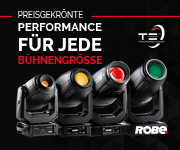Aktuelle News & Schlagzeilen
Version 2 supplies lighting and control infrastructure to the Queen’s Platinum Jubilee Party at the Palace
TV, broadcast and event lighting rental specialists Version 2 supplied the moving lights, control, cabling and power distribution infrastructure for the Queen’s Platinum Jubilee Party at the Palace, catering for the needs of all four stages and the audience areas, including the Royal Box, which had been built in front of Buckingham Palace.
As one of the main highlights of the four days of Jubilee celebrations that marked the 70th anniversary of the Queen’s accession to the throne, the Party at the Palace took place on the evening and night time of 4th June 2022. The two-and-a-half hour event with a global audience of 13.4 million viewers featured a programme of classic performances that began with Queen and ended with Diana Ross.
Produced by BBC Studio Events, and with a multi-stage design by Stufish, the set featured four stages: the Pop Stage and Orchestra Stage which flanked the Palace gates; the Palace Stage that linked the Pop and Orchestra stages; and the central “QVM” stage around the Queen Victoria Monument, connected to the rest of the set by a catwalk. The responsibility for lighting the event went to lighting designer Nigel Catmur and his team of five console operators supported by gaffer Mark Gardiner and his team of twelve site technicians, and the team at Version 2.
The performance areas were defined by seventy pillars - silk covered truss towers with custom mounting plates - that were designed in house by Version 2 and manufactured locally. “Not only were these key elements representative of the seventy years of service the Queen has given the country, they also provided mounting solutions for the moving heads that Nigel used to light the event, and were much easier for the crew to rig and access”, says Version 2’s Joe Marter.
Version 2 was approached by Catmur in January 2022 to supply the lighting after winning the tender process. Catmur and Version 2 worked closely together through various developments of the design, adapting kit lists to fit suitability and availability until a final design was signed off in April. This left about six weeks to procure 1009 lighting fixtures, most of which were supplied from Version 2’s rental stock, with cross-hire support from close collaborating companies.
Catmur was adamant from the outset that he wanted Robe BMFL followspots and Robe BMFL Blades as the keylights for all four stages. “Martin Mac Aura XBs were also a given,” he says. All these fixtures were protected from the elements under cover of the Pop and Orchestra stage roofs, but IP65-rating was essential for almost everything else. Catmur turned to Cameo as well and specified 142 Zenith W600 along with over 400 Flat Pros.
“Lighting the QVM stage was quite a challenge because of its position so far in front of the set up”, says the LD. “Central lighting positions would obstruct the sightlines up the Mall so we had to push the rigging positions much wider left and right than we would normally want to go. Consequently the angles were very wide and flat, but they worked extremely well and had the added advantage of being able to reach the outer edges of the Pop and Orchestra stages at the rear.”
“For the QVM stage front light we relied on twelve BMFL Blades and some Astera AX5 on the floor, backed up by four Robert Juliat Lancelot followspots and six BMFL Robospots”, he continues. “The followspots were rigged in a spot tower behind the audience seating above the press box, at the maximum height allowed, and operated by Dave Scrivens and his team of professional followspot operators from Pro Spot.”
The task of organising the logistics, and designing and installing the control and distribution infrastructure was the responsibility of freelance gaffer Mark Gardiner and his team of twelve technicians. Gardiner has known and worked alongside Nigel Catmur for a long time, and also for many years with Version 2 and its MD Nick Edwards. “With no pre-existing infrastructure on site, we literally had to build everything from scratch: stages, grandstands, pillars, etc”, says Gardiner. “My role was to put together the lighting for the show, book the crew, handle the logistics of every aspect from the trucking to the order in which we build the show components. This involved liaising with every department to ensure the correct kit was delivered to site over multiple days to keep the work schedule flowing.”
A major part of Gardiner’s remit was to design and install the lighting control system which entailed several kilometres of fibre supplied by Version 2. “From the central, custom-built control desk hub at the back of the south grandstand, we had the best part of 3 km of fibre cable running around the site”, he says. “The system was run on over 150 universes of DMX and had three types of lighting control across multiple networks on different V-LANs: ArtNet protocol, sACN and MA-Net. Alongside this we also integrated a High End Systems Hog across the sACN part of the network that was looking after all the screen content. This enabled this operator to take control of the brightness of the screens to be able to balance them as the light level dropped.”
Gardiner gave his list to Version 2 in advance, and they built the control racks to his specification. “We then spent four days with them at Version 2 HQ prepping all the control elements and building the entire system before moving on site at the end of May, with just a week of build up before rehearsals”, he says. “It wasn’t possible to connect all of these elements on site until day ten, so we built the whole system in the warehouse and linked it together with the actual length of fibre run we would use on site to replicate the ‘real’ conditions.
Full connectivity on site involved working with all the TV and sound departments to run cabling through subterranean tunnels and ducts, which in turn had to be organised with the Parks Authorities for the police to search the ducts beforehand and have an overview that it was safe once the lids went back down.
Nigel Catmur’s lighting team included Alex Mildenhall (lead programmer), Martin Higgins (assistant), Oliver Lifely (keylight programmer and associate lighting director), Matt Lee (media programmer), and Aaron Thomas from PixMob (wristband programmer).
Lighting equipment supplied by Version 2: 2 x Robe RoboSpot Motion Camera, 10 x Robe Forte EP, 33 x Robe BMFL Blade, 39 x Robe Spiider, 38 x Robe Megapointe, 10 x Robe I-Spiider IP65, 4 x Robe BMFL Followspot, 6 x Robe RoboSpot Base Station, 9 x GLP JDC1 LED Strobe, 4 x Robert Juliat Followspot Lancelot 4000W HMI (2-5), 396 x Cameo Flat Pro 12 G2 RGBWA LED Flood, 68 x Cameo Flat Pro 7 G2 RGBWA LED Flood, 142 x Cameo Zenit W600 RGBW LED Flood, 62 x Cameo Otos H5 Hybrid IP65, 66 x Martin MAC Aura XB Wash, 53 x Prolights Arenacob 4 RGBW LED, 37 x Prolights PanoramaIP WBX IP65, 16 x Astera AX5 LED PAR 8 Head Kit, 5 x Litepanels Astra 1X1 Bi-Colour Flood, 8 x Rosco Dash.
Control supplied by Version 2: 9 x GrandMA3 Processing Unit M 4096, 1 x GrandMA3 Processing Unit L 8192, 1 x GrandMA3 Processing Unit XL 16384, 6 x Luminex Gigacore 16RFO Fibre Switch, 4 x Luminex Gigacore 14R Switch, 13 x Luminex Gigacore 10 Switch, 20 x Luminex Luminode 12 Node, 1 x Luminex Luminode 4 Node.
SCHLAGZEILEN
news archiv
suche
© 1999 - 2025 Entertainment Technology Press Limited News Stories







